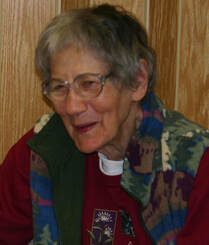 When I think about joy, one of my favorite people comes to mind. Margaret was an older member of the congregation I pastored in Jamestown, Rhode Island. She always had a smile on her face and a laugh on her lips. She was filled with a joy that spilled out and touched everyone who came in contact with her. Margaret was a walker. She walked with purposeful stride and a brisk pace, but that never kept her from stopping to speak to someone. When Margaret first moved to Jamestown, she didn’t feel welcome. No one was overly friendly. So Margaret became her own version of a joy-filled welcome wagon. She might not have felt welcomed, but she was determined to welcome others. In the process, she radiated a joy that was contagious. I sometimes wondered about the source of Margaret’s joy. While she never complained, her life hadn’t always been easy. She cared for her husband as he was dying. Then she did the same for one of her sons. On one of my last days in Jamestown, Margaret stopped by office. While we talked, she reminded me about a sermon I’d preached several years earlier. I had suggested people consider keeping a journal in which they would note things for which they were grateful. I learned that Margaret had been keeping a daily gratitude journal ever since. That day I began to understand that Margaret’s joy grew out of her deep sense of gratitude. She was grateful for the big and the little things in her life. She saw it all as a gift and that translated into joy. The professor and author Brené Brown has conducted extensive research related to joy. One of the most important things she’s discovered is the relationship between joy and gratitude.
Brown went into her research thinking that the relationship would be like this: If you are joyful, then you should be grateful. But she’s learned it isn’t that way at all. Brown says that over the years, she hasn’t interviewed a single person who describes himself or herself as joyful who doesn’t also actively practice gratitude. These people don’t just feel grateful. They have tangible gratitude practices. As I was reading about Brown’s research, I thought of a book on gratitude I read a number of years ago. And wouldn’t you know it? Just then Brown cited that very author. “The root of joy is gratefulness,” writes David Steindl-Rast. “It is not joy that makes us grateful; it is gratitude that makes us joyful. . . . The opposite of gratefulness is just taking everything for granted.” Brother David, a Benedictine monk, believes in the transforming power of living gratefully. Not just when something wonderful or special happens, but every day, no matter what is happening. When people ask Brother David how they might practice that kind of gratitude, he offers a simple response: Stop, look, go. Most of us, he explains, are caught up in schedules and deadlines and rushing around. So the first thing we need to do is stop. Otherwise we’re not present and can’t appreciate the opportunity that’s given us because we rush by it. Then we need to look. To see what unique opportunity any given moment offers. And if we really see what the opportunity is, we must do something with it. As much as I appreciate Brother David’s writing and teaching, I find myself wondering how applicable they are right now. He suggests that we stop, but it feels like we’ve been stopped for months. Many of us haven’t had to rush to get to the office or our classroom. For those who have continued to go to their workplaces, there hasn’t been rush-hour traffic. And rushing to other things that often filled our schedules—lunches, rehearsals, sporting events, even church meetings—feels like a thing of the past. During this far-from-ordinary time, could there be something else we need to stop if we’re to practice the gratitude that can lead to joy? Perhaps that thing is what Brene Brown calls “dress rehearsing tragedy.” Rather than opening ourselves to the vulnerability of feeling joy, we imagine all the bad things that might happen. We wake up in the morning and think: “My job is going great. My parents are healthy. I have good friends. , , , This can’t last.” Or we look at our children and feel this deep love, only then to picture something terrible happening to them. Brown has noticed a difference in people who seem to have a profound capacity for joy. When something delightful happens to them, they’re grateful. Instead of using it as a warning to start “dress rehearsing tragedy,” they use it as a reminder to practice gratitude. The choice really is ours. We can imagine all the ways that things can go wrong, which often stops us from practicing the gratitude that leads to joy. Or however much fear and insecurity seem to fill our culture, however low the trends and opinion polls seem to sink, however accurate diagnoses of doom and gloom seem to be, we can refuse to yield to a spirit of despair. We can choose what one writer calls “the subversive act of genuine joy.” I know that choice is possible because I’ve seen genuine joy striding through Jamestown in the form of a woman named Margaret. KP
1 Comment
Pamela Carr
6/21/2020 09:16:08 am
Kathryn, You nailed it on this one. I miss Margaret every day when I walk down Narragansett Ave. I miss seeing her walking down the street! She is forever in my thoughts!
Reply
Leave a Reply. |
Kathryn PalenAssociate Executive Minister Archives
January 2023
Categories |
 RSS Feed
RSS Feed